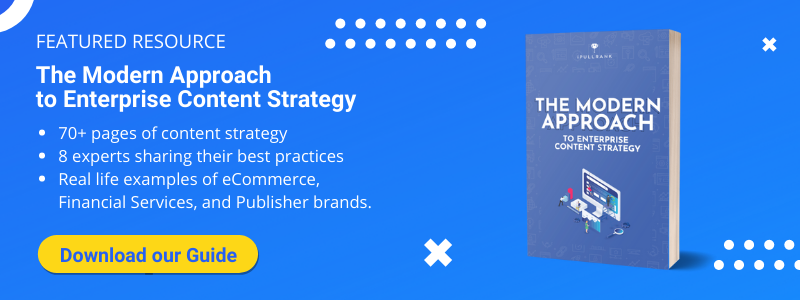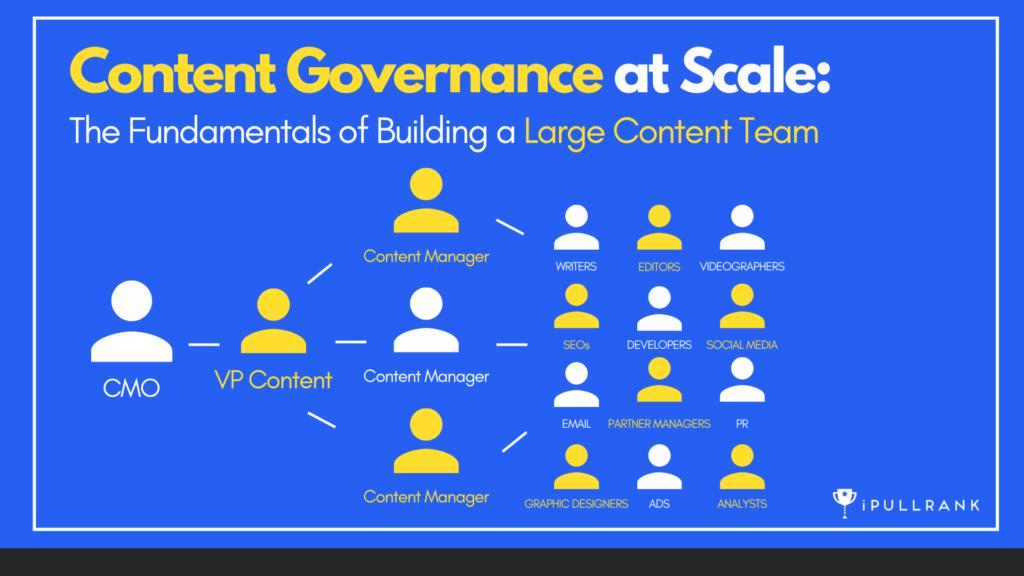What’s the secret to a high-performance content team?
It’s about having exceptional content that creates value. No, it’s about the people on the content team and their skill sets. Wait, maybe it’s about workflows and how teams work together?
Who’s right here?
None of these perspectives get it right. These details are an essential part of a large content team, but there’s a detail that matters much more.
I’m sure you’ve already guessed it.
It’s governance. Governance is the essential component you need to build a large content team. Today, we’ll look at the fundamentals and the role governance plays in building a large content team.
Why governance is the scaffolding behind successful content
Before I explain why governance is essential, we need to be clear on what it is.
Content governance is the system you use to manage your content. Your governance plan dictates how your organization creates, publishes, promotes, and manages content. This plan outlines your goals and objectives and defines the roles and responsibilities of your team and the workflows used to accomplish results.
A governance plan provides your team with their marching orders. Everyone on your team has a keen understanding of the work that needs to be done. It outlines everything in detail — the roles and responsibilities of each team member, the resources you have available, and the way content should be produced.
But is it really essential?
Here are a few scenarios that demonstrate the importance of content governance.
- Content teams that don’t have a governance plan often publish content with inconsistent quality. There is no clarity on content length, depth, style, tone, voice, or goals, so the results achieved are hit or miss.
- Your content creates conflicts (e.g., conflicting value propositions, goals, and content targeting the same keywords) that diminish content performance over time.
- There’s a lot of overlap as team members are unclear about their roles; copywriters, SEOs, and marketers create the same content or take on the same responsibilities.
- There’s a lack of clarity about who did what and when or who will complete certain responsibilities in the future — team members think someone else will take care of that issue, so nothing gets done.
- Teammates disagree on how work should be done. There’s no clearly defined process, so team members rely on their own experience or apply their own criteria when completing tasks.
Your governance plan is the blueprint your content team follows. Before we dive in, let’s start with the obvious question.
Who is this guide for?
It’s for the professional that’s responsible for content marketing — a new VP of Marketing, Head of Content, your Chief Content Officer, or Content Director. I’m going to assume that you’re somewhat prepared, you have bits and pieces of a team in place or a full team that’s ready to go.
Use this guide to vet your team.
The first two steps of this guide will focus on (a.) outlining your goals and objectives and (b.) auditing the team and benchmarking performance. These two steps pave the way for success. Investing the time in upfront preparation means your team will hit the ground running when it’s time to launch your content marketing campaigns.
Okay then, what’s the first step?
Outline your goals and objectives
It boils down to a why.
Why do you want to build a large content team? What are the specific goals and objectives your organization is working towards?
There’s this myth in content marketing.
It’s the view that content marketing can’t be measured, that it’s nothing but nice words and pretty pictures. It’s viewed as helpful to the organization in a vague and imprecise way. It’s not true, but it’s still an issue that needs to be addressed (for the executive’s sake).
Content is marketing, and marketing is goal-driven.
Another detail that changes your content marketing focus is your business model. Content, at all stages of the buyer’s journey, should be driven by your goals and objectives. Here are a few examples.
- For eCommerce retailers (direct sales), metrics like customer churn and average order values change your content marketing focus. Your content will be oriented around these key metrics (driving sales, increasing upselling, down-selling and cross-selling opportunities, repeat sales, etc.)
- Service providers focus on lead generation, nurturing, and conversion. They’ll spend a significant amount of time pre-qualifying and disqualifying candidates ahead of time to minimize the amount of time spent with unqualified candidates.
- Publishers and media companies spend their time focused on other metrics —time on page, bounce rates, page views, top content, etc. These organizations will focus primarily on creating ‘sticky content’ — the kind that maximizes ad revenue and subscriptions.
- Digital vs in-person sales have their own distinct goals as well. Digital is straightforward — get the click, get the conversion. In-person is a bit more complicated, schedule a meeting, book a date and time, request a proposal, get a quote, etc. It requires more commitment which means your content needs to extend that trust and commitment first, on the front end.
Each step in the governance process depends on the goals and objectives you set ahead of time. These goals are behavior drivers that orient your organization around a common purpose. Here are 15 of the most common goals used by content marketers.
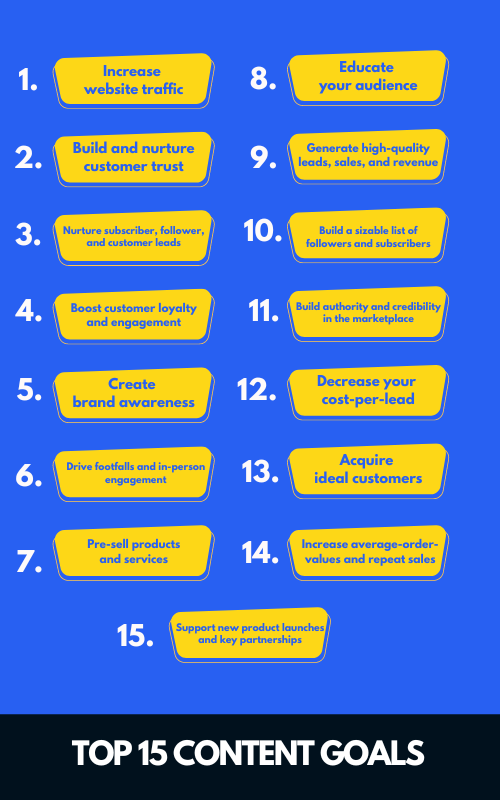
- Increase website traffic: Traffic equals visibility and attention; The more attention you receive the easier it is to generate leads, drive sales, win new customers, or increase revenue. Content is the bait, promotion is the fishing rod that reels your audience in.
- Educate your audience: Good education acts as an attractor. It exposes a customer’s need for your product or service, clarifies their wants and needs, creates interest, and incentivizes action.
- Build and nurture customer trust: Consistent content creates trust. When your audience receives a steady flow of value-rich content, their trust grows. It’s this consistency that helps to move them through the buyer’s journey.
- Generate high-quality leads, sales, and revenue: The quality of leads generated via content is drastically different from the leads received via paid media. Both are effective but with paid media, there’s generally a whole lot of qualification that needs to take place before customers are willing to buy. This can be negated via extensive branding but it takes time. Content amplifies this for existing brands and maximizes this for growing brands.
- Nurture subscriber, follower, and customer leads: There’s an ebb and flow to relationships — sophisticated content marketers use their content to build engagement with their audience. Broadcasting content isn’t enough, a two-way conversation needs to take place if the relationship will grow.
- Build a sizeable list of followers and subscribers: Subscriber and follower counts are self-sustaining very early on, but they still require consistent effort to minimize churn as subscribers and followers leave your audience. Your list needs to be pruned from time to time, and list building is an ongoing process.
- Boost customer loyalty and engagement: Trust increases by default, provided that the relationship is healthy and provides value. Consistently nurturing relationships with quality content boosts engagement and fosters loyalty. You’re providing your audience with value that’s difficult or impossible to get elsewhere.
- Build authority and credibility in the marketplace: If your brand and content are credible, building authority and credibility happens automatically. Your authority and credibility are directly tied to the value you provide, the trust you build, and the quality of your content.
- Create brand awareness: Your brand is your reputation. The more consistent your audience’s experience is with your content and your performance, the easier it is to build brand awareness.
- Decrease your cost-per-lead: Short-term relationships increase your CPL. Content marketing produces a lower CPL because content builds and nurtures relationships over time. Individuals qualify or disqualify themselves, at their own pace. By the time your audience members approach you with the intention to spend, they’re pre-qualified, educated, and prepared.
- Drive footfalls and in-person engagement: Content that’s incentivized can be used to drive footfalls and in-person visits. Reservations, discounts, special timed offers, bonuses, vanishing products, etc. are all content types that can drive in-person engagement.
- Acquire ideal customers: Ideal customers are promoters, true believers who are able and willing to buy your products and services. They’re engaged, eager, and focused on the value you provide. These customers are willing to spend whatever they need to, to purchase your offering.
- Pre-sell products and services: Content pre-sells your products and services, using content you can address concerns, problems, and other issues well before they become a lead. With the right kind of content, you’ll be able to generate revenue from content that promises to solve a problem or delight customers. Your content has built a trust relationship, precisely what customers need to take a risk.
- Increase average-order-values and repeat sales: Education exposes problems. For example, if customers purchase a cellphone education tells them they’ll need screen protectors, a case, headphones, battery packs, etc. Content built around these problems increases average order values and drives repeat sales.
- Support new product launches and key partnerships: If you’re looking to recruit partners your content is a key component. Your content is an important variable that partners will use to vet your company. Are you creating content that is credible or will your partners be embarrassed by the material you share? Do we share similar values (e.g., social benefit)? Is this reflected in your content?
Precise goal setting is important because it changes your governance plan and how your content marketing is implemented.
- If you’re focused on building a sizeable list of followers and subscribers, your content should integrate social media (e.g., shares, retweets, likes, follows) into your content formats. This incentivizes readers to take action and engage with your content.
- What if your goal is high-quality lead generation and sales? Your content will need to be practical, aligned tightly with customer problems, and focused on building profitable relationships with customers (e.g., subscriber > customer, > repeat customer).
- What about increased brand awareness? Your content team should spend a significant amount of time collaborating with tangential sources (e.g., guest posts, joint webinars, channel partnerships, etc.) both on and off-site.
- Is your focus on increasing website traffic from search? You’ll want to emphasize the on-page and off-page factors you use to build your site and create your content. This means paying placing special emphasis on social media and ranking factors.
See what I mean?
Your goals and objectives should directly impact your governance plan and how your content teams function. This is especially important because your goals and objectives help you audit your organization. They give you a clear sense of where you are now, where your organization needs to be, and what it will take to get there.
Audit your content team
The next step is an internal audit. You’ll want to inventory the people, roles, responsibilities, and processes you have in place. This audit is important because it helps you discover the gaps that need to be filled in your content team and the redundancies that might exist.
An audit of your content team should cover four specific areas:
- Your current budget: Can your current budget support your goals and objectives? What steps should you take to increase your budget over time? This should include details on creating a data-driven budget pitch that will motivate executives to give you the funding you need. Assume skepticism. Every dept has a budget request; what makes your request special?
- Your current performance assessment: This is a quantitative and qualitative analysis of your current situation across various metrics (e.g., backlinks, clickthrough rates, traffic, conversion rates, social shares, rankings, engagement, time-on-page, bounce rates, etc.)
- Your organization’s desired outcomes: These are the business objectives of the company as a whole, not just your department. Your team goals must align with the company’s goals. If there’s a variance or your goals are disconnected from the bigger picture, your content team won’t have the support it needs.
- The specific steps to achieve these outcomes: This ties into your workflows; your content team has clear goals and objectives that align with the company’s overall goals. Your workflows plot the step-by-step, day-by-day activity that needs to take place to reach these goals (e.g., increase organic search traffic by 35% in the next 6 mo., increase opt-ins by 16%).
After completing the high-level planning and assessment, you should evaluate how you will execute your plans and who will contribute. Building out the team will be heavily influenced by your budget.
- Content Team Roles
- Individual Responsibilities
- Procedures and Workflows
- Resources (e.g., training, education, software, tools)
Content Team Roles
No one in the C-suite is going to give you a blank check. When it comes to head count you’re going to need to sell executives on specific roles and needs; these needs typically require an increase in budget, so you’re going to need to quantify the value these roles will bring to the department and the company.
What does a well-rounded content team look like? Are there specific skills the content team needs to fill any gaps?
Here’s a look at some of the roles you’ll fill on your content marketing team.
- Chief Content Officer: Your CCO is the CEO of content; They’re responsible for your content team’s overall strategy and direction. Great CCOs tie your company’s products and services to the content your team produces. They’re responsible for making sure your team’s content makes dollars and cents. This title will differ depending on the organization and makeup (e.g., SVP of content and production).
- Content Manager: A project manager, traffic manager, and marketer rolled into one. These individuals are highly organized professionals who research topics, complete keyword research, assign content, create content briefs, etc. They manage each stage of the content production pipeline and ensure that everyone is on track and deadlines are being met. Your organization may have a single content manager or many depending on the size of your team and the structure of your organization. Each of these managers should report to your CCO for their respective areas, keeping the chain of command as flat as possible.
- Managing Editor: Someone who creates your team’s editorial calendar, manages the day-to-day editorial process, and controls content production flow. They ensure content means brand, quality, and style guidelines verifying that the content your team produces is consistent.
- Publishers: These professionals make content visible for your readers to consume. They upload content to your organization’s CMS, select images, add title and meta-description content, and add internal and external links to existing content. These publishers typically also handle any minor issues (e.g., minor errors, grammar, tone, etc.). Publishers with a background in SEO will find they’re better able to work with other roles.
- Graphic Designer: These creative professionals create visual content, whether that’s infographics, images, charts, diagrams, edited images, print designs, digital collateral, etc. Graphic designers also function as gatekeepers, ensuring that your visual content adheres to your company’s brand guidelines whether they’re working with earned, owned, shared, or paid media.
- Front-end Designers: These designers design web pages, quizzes, specialty apps, forms, interactive content, and resources for your web properties. They bring your team’s designs to life by creating pages that amplify user appeal and fascination, decreasing cognitive fluency, decreasing bounce rates, and increasing time on site.
- Web Developers: Developers are the engine of your content team. Your content team should have its own, dedicated team of web developers. These professionals create the tools, resources, and applications your team needs to work; some great examples include the interactive content from Vox and the New York Times.
- Search Strategists: SEOs get your content in front of the right people. They maximize the number of referrals your organization receives from Google, Bing, Yandex, etc.; using on-page and off-page strategies, they keep your content in line with the trends and changes in your industry. SEOs are responsible for technical SEO, internal linking, inbound vs. outbound links, etc. While publishers handle the administrative functions of content marketing, SEOs focus on the logistical and strategic elements of search (e.g., 301 redirects to maximize link equity). Successful SEOs take a leadership role in the publishing process but rely on publishers to handle implementation and scale issues.
- Community Managers: These are your social media darlings; they actively promote your content on social media, maximize engagement with readers, prospects, and customers, and provide customer service from time to time. These professionals are personable, warm, helpful, and attentive. Community managers are also known as Social Media Managers, Social Media Producers, or Director of Community.
- Email Marketing Specialists: These marketing professionals are responsible for building, nurturing, maintaining, and growing your email lists. They’re responsible for optimizing email automation workflows, segmenting subscriber lists, running A/B split tests, gathering insights on subscribers and engagement, and more. Their focus can be distilled down to three goals: get subscribers to opt-in, get them to open the email, and get them to click.
- Copywriters: Your writers have one job, get the click. They’re responsible for creating content your readers are eager to consume, reference, and share. They create powerful headlines and subheadings, craft compelling CTAs, and incentivize readers to convert. These professionals are writers first. They’re not SEOs, marketers, or graphic designers who are suddenly responsible for creating content. This role is typically filled with in-house talent, freelance talent, or a mix of the two.
- Videographers: They film video content on set or on location. They collaborate with creative teams, ensuring that video content is in-line with the company’s brand guidelines. They handle all areas of video production and pre and post-production tasks. These professionals are our team’s go-to for stock footage and content that aligns with your company’s brand, style, tone, and message.
- Data Analysts: Are your efforts paying off? Is your work bearing fruit? Your data analysts are specialists who can provide managers and executives with a definitive answer to these questions. Your analysts should be able to provide you with quantitative and qualitative answers — are you meeting expectations, exceeding expectations, or failing? Your analysts offer the team important course correction advice. Do you need more internal links? Should you focus on a different keyword cluster that’s producing more revenue? Inbound links from which source produces more revenue? Your analysts are the key to iteration; they’re an essential part of your team.
- Content Promoters: These professionals generate attention and traffic for your content. They divert traffic accordingly, shifting between evergreen and trending content. These content promoters may be influencers, agencies, or media specialists. They may be in-house or freelance; if 20% of your team’s time is spent on content production and 80% on promotion and growth, they should be able to generate visibility and traffic on demand.
- Contributors: These are the individual content creators on your team. These creators could be employees, freelancers, agencies, actors, third-party contributors, etc. They could be videographers, copywriters, or specialists; their work should be vetted, their content should adhere to your guidelines, and their content should be verified and fact-checked.
- Partner Manager: These managers broker, administer, and manage deals between various partners or sponsors. These could be channel partners, strategic alliances, JV partners, etc. These partners have a substantial platform; Partner Managers work to broker deals that extend your organization’s reach considerably. These relationships are typically an ‘ ‘I’ll scratch your back if you scratch mine” relationship; Partner Managers typically focus their attention on tangential sources who serve the same audience.
You may also have an assorted list of interns, coordinators, and specialists to manage a variety of content-related tasks — PR, brand management, project management, marketing coordination, social media management, copyediting, and more.
Now, take a look at these roles.
Which ones do you have? Which ones do you need to accomplish the goals and objectives you outlined in the first step? You can always add more roles, but these are the essentials you’ll need to build a large content team.
What if you don’t have the essential roles filled?
That’s not a problem. You can work with freelance or contract help to fill these roles temporarily. What’s essential is that you have the liaisons in place to communicate with other teams and departments.
Individual Responsibilities
We have a clear idea of the roles needed for a large content team. What are the responsibilities for each role? Here are a few criteria you’ll want to follow to document this properly.
- Outline and communicate your day-to-day expectations for each role
- Make a list of all the tasks in each position
- Add the specific credentials, competencies, skills, and qualifications you want
- Disclose your company’s standards and expectations
Not sure where to start?
Here are sample job descriptions for each role.
- Chief Content Officer
- Content Manager
- Managing Editor
- Publishers
- Graphic Designer
- Front-end Designers
- Web Developers
- Search Strategists
- Community Managers
- Copywriters
- Videographers
- Data Analysts
Use each of these job descriptions as a springboard; be thorough when describing the responsibilities for each role. Make sure there isn’t a significant amount of overlap for each role.
Procedures and Workflows
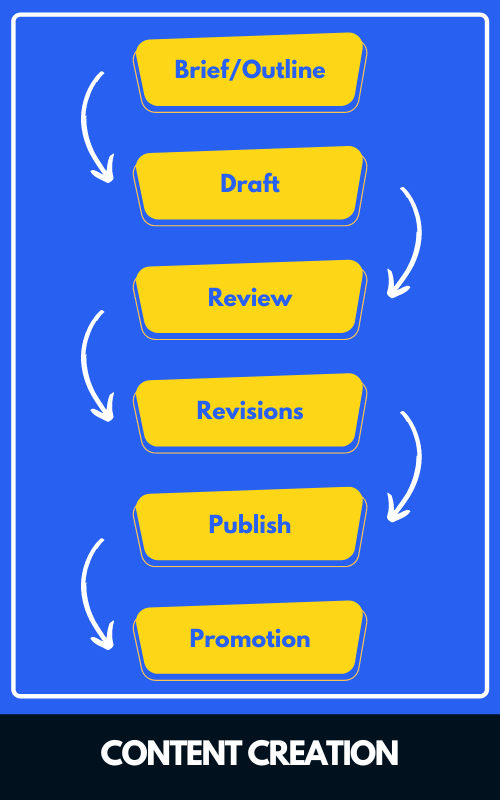
Most content workflows follow some variation of these six steps.
- Brief/outline
- Draft
- Review
- Revisions
- Publish
- Promotion
Outline the roles responsible for each of the six steps above.
Walk your content through each of the six steps above. What are the entry and exit points for each piece produced? Who is responsible for each step? What do they do at each stage?
Here’s a simple example.
- Content manager creates briefs
- The managing editor assigns briefs and guidelines to a contributor in Asana
- Publishers add contributors to Asana
- Contributor or copywriter writes draft
- Managing editor, search strategist, and publishers review the draft
- Managing editor requests draft revisions from contributor or copywriter
- Graphic designer creates images, charts, and downloads for draft
- Managing editor approves draft
- Publisher uploads content and assets to CMS, title, meta description, and post description, publishes post
- Data analyst creates tracking URLs (sorted by channel, campaign, source, medium, keyword, etc.), set conversion goals where appropriate
- Community managers receive tracking URLs from data analysts, create promotion schedules, share/schedule posts for publication on social media profiles
- Content promoters receive tracking URLs from data analysts and share post via marketing channels (e.g., earned, owned, paid)
- Tracking URLs are added to the post. Post is shared with content partners and syndicated for # months.
- Data analyst provides weekly updates, tracking content performance across key metrics and KPIs
- Team leads check in weekly with the content manager and the chief content officer
Map the content creation process out.
Document the process from A to Z for all content types (e.g., posts, whitepapers, infographics, guides, quizzes, etc.). Again, outline the entry and exit points for each type of content.
Next, what are the policies, procedures, and workflows for each step in your company? How do the roles mentioned above fit in with these six steps? For example, your content guidelines could include instructions on:
- Brand voice
- Dos and don’ts
- Jargon and terms
- Style preferences
- Target audience
- Tone
- Revisions
Want to see a best-in-class example of content guidelines? Check out the dynamite content guide that the team at Content Harmony put together. MailChimp has invested a ton of resources into its brand guidelines.
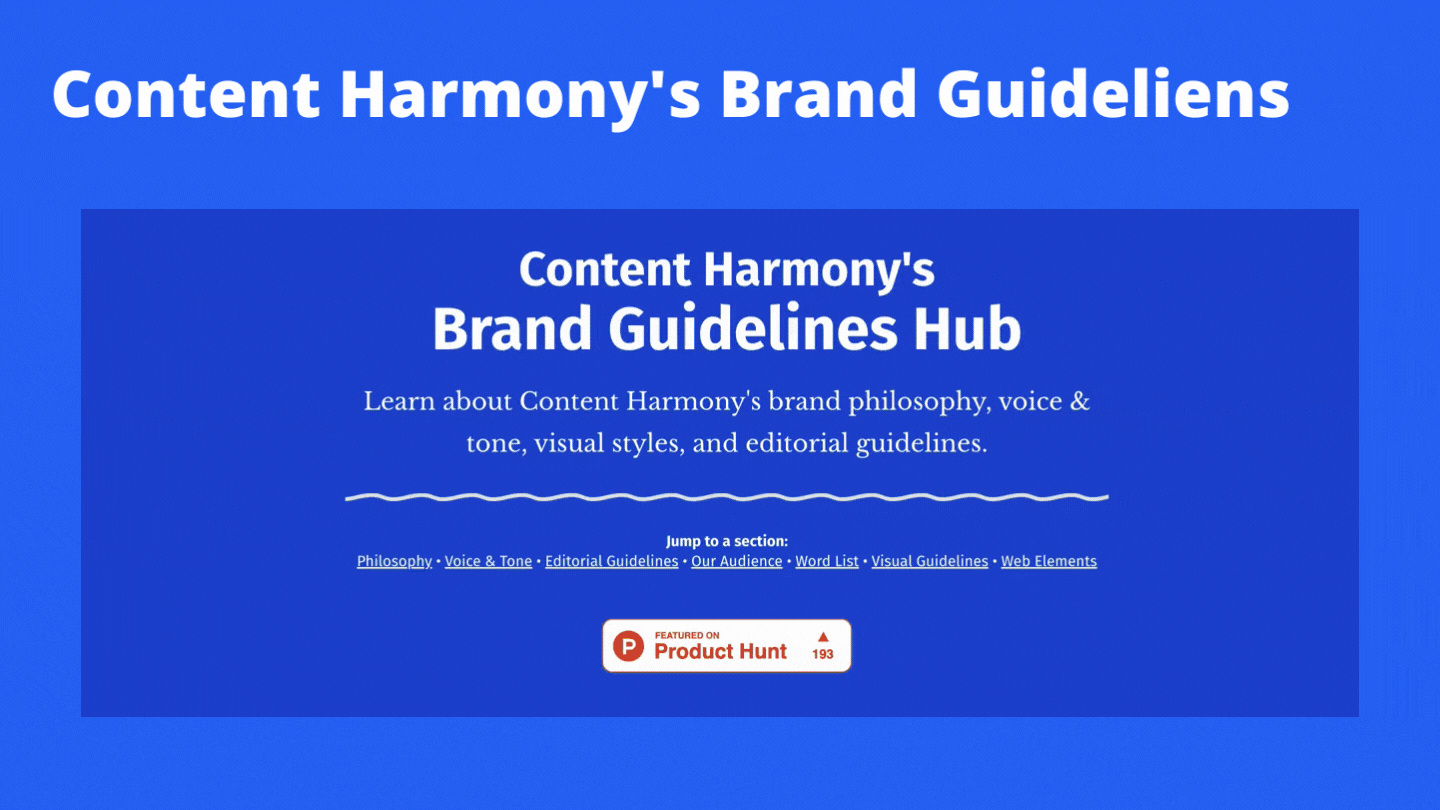
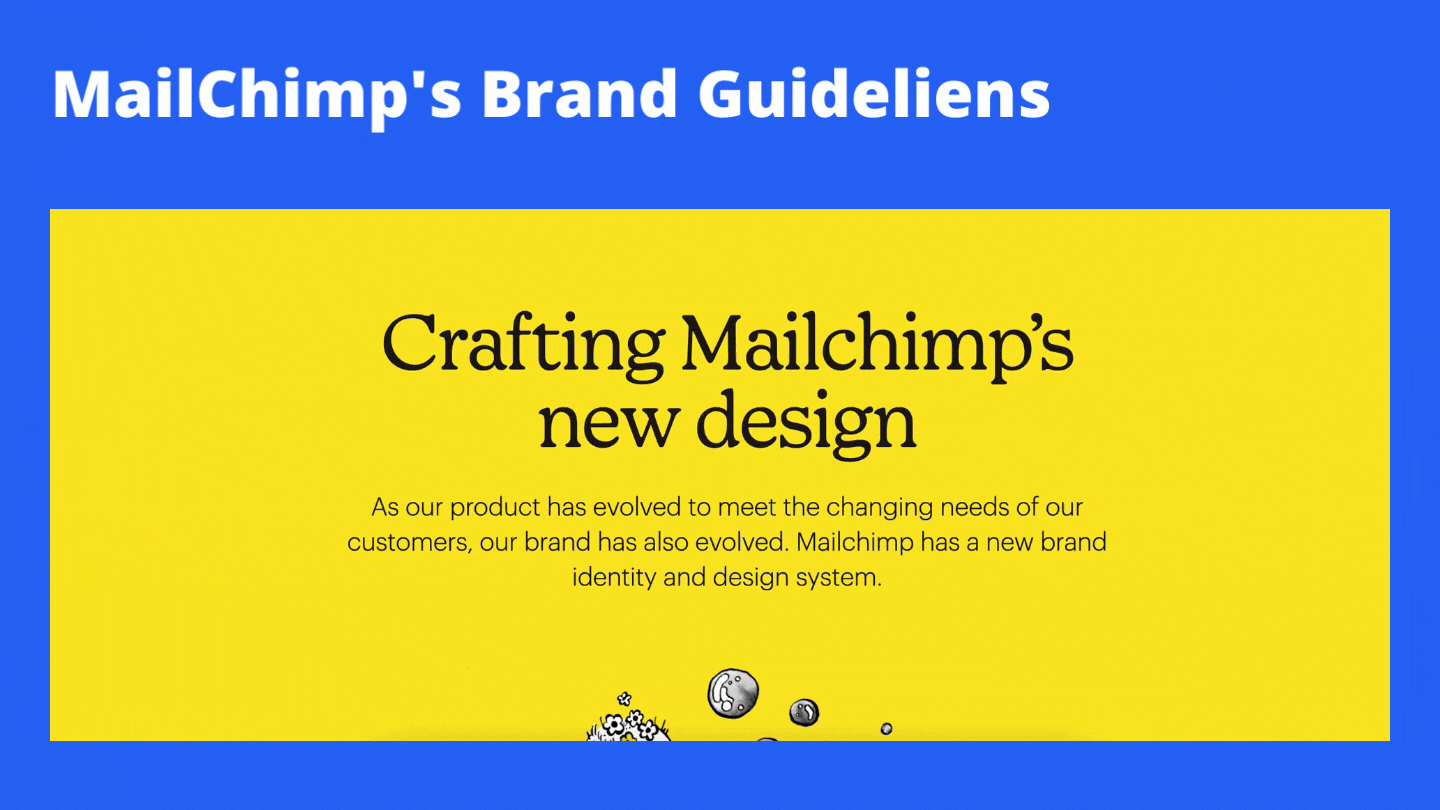
Finally, make sure that this documentation lives in a centralized location that’s available to each of the right people. Tools like Trainual, Lattice, and Leapsome are excellent SaaS options for your team. Make sure the solution you choose has the right security protocols in place (e.g., principle of least privilege). Set rules and requirements that outline how the team should use this documentation, and how often it should be reviewed, updated, or edited.
Resources (e.g., training, education, software, tools)
Your content team has needs.
They’ll need a significant amount of resources from you if they’re going to perform well consistently. These resources are as follows:
- Training in the form of courses, certifications, one-on-ones, books, workshops, seminars, and events
- The software they need to complete their work (e.g., project management, grammar and spell checkers, creative and development software, etc.)
- Internal education that provides them with the instruction they need to do things your way; this consists of internal company training and continuing education
- Tools that are an essential part of the job; these could be development libraries for your front-end team, templates for your managers and editors, and research libraries for your copywriters, contributors, and publishers
Each of these items should be curated, collected, or prepared ahead of time.
You’ll want to take an inventory.
Make a list of the needed training, software, education, and tools for each role. Provide your teams with materials that are easy to understand, comprehensive, and up to date.
Budgeting 101: Where do you start?
Start by identifying how much budget you have left.
If it’s the beginning of your fiscal year and you’ve just received a substantial budget increase, you have a lot of wiggle room. What if it’s the end of your fiscal year, and you’re running low on funds?
Start where you can.
If you’re low on funds, lean on your chief content officer or content manager. Get them to identify quick content wins you can use to get results. Use these results to build a budget pitch your C-suite can’t resist.
What if you’re flush with cash?
You’ve planned your work; now it’s time to work on your plan. Use your goals and your budget to create and implement your plan.
How do you do that?
- Identify your working budget
- Work with your chief content officer or content manager to establish your breakeven cost
- Set your budget based on the cash you have and the goals you outlined in step #01
- Pair your organizational goals (rapid growth = more budget, stable growth = less budget) with your team goals (e.g., 3x our leads, sales, and revenue)
Then you work from there.
Working with an agency is best if you’re looking to grow rapidly. If you’re looking for stable and systematic growth, or you’re looking to establish your team before scaling, work with freelancers.
You can also rely on both.
Use both if you need content specialists, but you’re also looking for rapid growth. Your agency will help your content team optimize and scale your content. Freelancers will provide you with the 10x content and specialized knowledge you need.
It’s a win/win.
These are the fundamentals of content governance.
Large content teams need a governance plan
A governance plan provides your team with the blueprint everyone needs to perform. With the right plan, your team has a keen understanding of content production — the roles and responsibilities of each team member, the resources you have available, and the way your content should be produced.
Content strategy can be measured.
Content governance gives your team the confidence it needs to scale content production. Get the help you need to create your governance plan; you’ll have clear direction on your organization’s roles, responsibilities, resources, and procedures—everything you need to build a high-performance content team.
